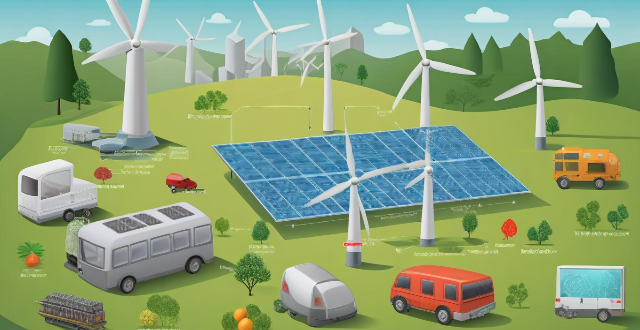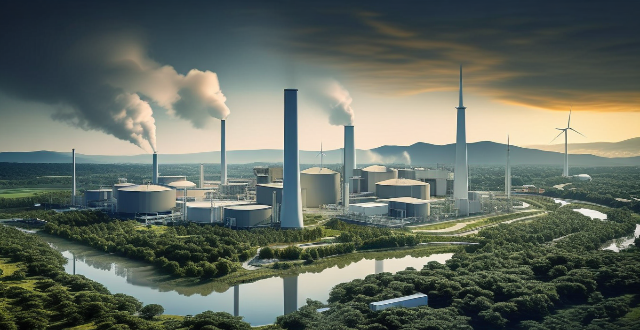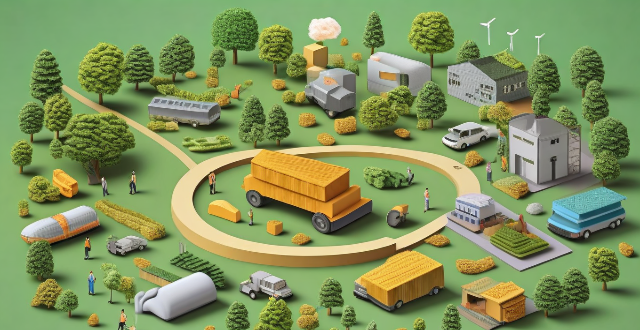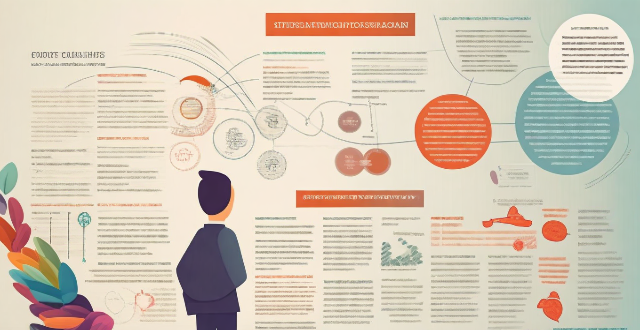Green Emission

What are some effective strategies for promoting energy conservation and emission reduction ?
Energy conservation and emission reduction are crucial for sustainable development and addressing climate change. Effective strategies include education and awareness, government policies and regulations, financial incentives and subsidies, technological innovation, infrastructure and urban planning, and individual actions. By implementing these strategies, we can work towards a future where energy is used efficiently, emissions are reduced, and our planet is protected for generations to come.

What role do governments play in achieving global emission reduction targets ?
Governments play a crucial role in achieving global emission reduction targets by setting and enforcing environmental standards, investing in clean energy infrastructure, promoting energy efficiency, supporting research and development, and collaborating internationally. These actions help reduce greenhouse gas emissions and promote a healthier environment.

How can green technology reduce carbon emissions ?
In this article, we explore how green technology can help in reducing carbon emissions. We discuss renewable energy sources such as solar, wind, hydro, geothermal, and biomass energy, which produce little to no greenhouse gas emissions during operation. We also emphasize the importance of improving energy efficiency and conservation, utilizing carbon capture and storage technologies, and promoting electric vehicles. By implementing these green technologies, we can significantly reduce our carbon footprint and create a more sustainable future for generations to come.

How do emission trading schemes work and are they effective ?
Emission trading schemes are market-based mechanisms designed to regulate the release of pollutants, especially greenhouse gases like CO2. These schemes operate on a "cap and trade" principle, whereby a regulatory body sets a limit on emissions, allocates emission allowances, and allows businesses to buy and sell these allowances in a marketplace. Companies must monitor and report their emissions, facing penalties for non-compliance. The effectiveness of such schemes varies but offers advantages like cost-efficiency, flexibility, and innovation incentives. However, challenges include complexity, political will, leakage, and equity concerns. Case studies like the EU ETS and California's Cap-and-Trade Program show mixed results, indicating that while emission trading schemes can be effective, their success depends on careful planning, robust implementation, and continuous evaluation.

What are the challenges faced by developing countries in emission reduction ?
Developing countries face numerous challenges in reducing their greenhouse gas emissions, including lack of financial resources, technological constraints, socio-economic factors, policy and regulatory challenges, cultural and educational barriers, and natural resource availability. These challenges highlight the complex nature of emission reduction efforts in developing countries and underscore the need for international cooperation, financial assistance, and technology transfer to support their transition to a low-carbon future.

Are current emission reduction efforts enough to combat climate change ?
The article discusses whether current efforts to reduce emissions are sufficient to combat climate change. It outlines various initiatives, including national pledges, renewable energy expansion, energy efficiency measures, carbon pricing mechanisms, and forest conservation. However, it argues that these efforts fall short of the required targets, pointing out gaps between commitments and reality, insufficient policy support, and challenges in changing behaviors and cultural norms. The article suggests increasing the ambition of national commitments, enhancing energy transition policies, investing in innovation and research, promoting international cooperation, and encouraging sustainable lifestyles as ways to improve emission reduction efforts.

What is the impact of renewable energy on emission reduction goals ?
The shift to renewable energy sources such as solar, wind, hydro, and geothermal power is vital for reducing greenhouse gas emissions and achieving global emission reduction goals. This transition brings multiple benefits including decreased reliance on fossil fuels, improved air quality, enhanced energy security, economic stimulation through job creation and long-term cost savings, technological innovation leading to reduced costs, and significant contributions to mitigating climate change. As technology advances and economies of scale are achieved, renewable energy's role in facilitating further progress toward emission reduction objectives will become increasingly important.

What role do green bonds and other financial products play in climate financing ?
Green bonds and other financial products are crucial for climate financing, enabling investors to support environmentally friendly projects. These instruments fund renewable energy, energy efficiency, waste management, biodiversity conservation, and other eco-friendly initiatives, contributing to climate change mitigation and sustainable development. Key features of green bonds include transparency and verification, offering benefits such as attracting capital and pricing advantages but facing challenges like standardization and secondary market liquidity. Other financial products include climate-themed investment funds, CERs, green loans, and credit facilities, which directly finance green projects and stimulate innovation in sustainable practices. By aligning financial returns with environmental benefits, these instruments play a vital role in mobilizing private capital towards climate action, helping to bridge the funding gap for sustainable projects and mitigate climate change.

What role do banks play in promoting green finance ?
Banks promote green finance by offering loans for sustainable projects, investing in eco-friendly companies, and introducing green products. They also educate customers on sustainability and collaborate with governments and NGOs to support green initiatives.

What are the main objectives of energy conservation and emission reduction policies ?
Energy conservation and emission reduction policies aim to achieve several key objectives that are crucial for the sustainable development of our planet. These objectives can be broadly categorized into environmental, economic, and social dimensions. The main goals include reducing greenhouse gas emissions, protecting ecosystems and biodiversity, improving air quality, enhancing energy efficiency, stimulating innovation and job creation, reducing dependence on fossil fuels, promoting equitable access to energy, and raising awareness and education. By addressing these objectives, these policies play a crucial role in steering our societies towards a more sustainable future.

How can governments encourage companies to adopt energy conservation and emission reduction measures ?
Governments can encourage companies to adopt energy conservation and emission reduction measures by implementing a combination of strategies including financial incentives, regulatory measures, information and education campaigns, research and development support, public procurement policies, and partnerships and collaborations. These efforts not only contribute to environmental sustainability but also foster innovation and economic growth in green industries.

Can energy conservation and emission reduction policies help combat climate change ?
Energy conservation and emission reduction policies are essential for combating climate change. These policies aim to reduce energy consumption, promote renewable energy sources, and decrease greenhouse gas emissions. Improving energy efficiency and encouraging energy conservation can significantly reduce energy consumption. Increasing investment in renewable energy technologies and supporting research and development of clean energy technologies can help reduce reliance on fossil fuels and decrease greenhouse gas emissions. Implementing carbon pricing mechanisms and regulating industrial emissions are also important strategies for reducing greenhouse gas emissions. Overall, these policies play a vital role in mitigating the effects of climate change and working towards a more sustainable future.

How does green finance contribute to sustainable development ?
Green finance plays a pivotal role in driving sustainable development by channeling financial resources towards environmentally friendly projects and initiatives. Here's a detailed look at how it contributes: 1. Promoting Renewable Energy 2. Supporting Green Infrastructure 3. Advancing Clean Technology 4. Influencing Corporate Behavior 5. Regulating Financial Markets 6. Educating Investors and the Public

What is green finance ?
Green finance is the use of financial instruments and strategies to support environmentally friendly projects. It includes sustainable investing, green bonds, green banks, carbon credits, impact investing, climate-related disclosures, ESG criteria, green indexes, green funds, green insurance, green tax incentives, green microfinance, green real estate, green technology, and green partnerships. The goal of green finance is to promote economic growth while minimizing negative impacts on the environment.

How can we promote the use of green technology ?
Green technology is essential for mitigating climate change and ensuring a sustainable future. To promote its use, strategies include education campaigns, integrating sustainability into school curricula, offering financial incentives and tax breaks, implementing regulations, funding research and development, encouraging corporate responsibility, supporting community projects, showcasing successes, participating in global agreements, promoting eco-labeling, and encouraging green marketing. These efforts can drive innovation, create jobs, and foster economic development sustainably.

Can we achieve a zero-emission economy by 2050 ?
The question of whether we can achieve a zero-emission economy by 2050 is a complex one that involves multiple factors. Key points to consider include the current state of emissions, challenges to achieving zero emissions, and potential pathways to achieving this goal. Currently, global emissions are still rising, with the transportation sector being a major contributor. While there have been significant advancements in renewable energy technologies, their adoption rates vary widely across different regions. Challenges to achieving zero emissions include building the necessary infrastructure for a zero-emission economy, political will, and public acceptance. Governments must be willing to implement policies that support the transition to a zero-emission economy, and the public must be willing to adopt new technologies and change their behavior to reduce emissions. Potential pathways to achieving zero emissions include increased investment in renewable energy, electrification of transportation, carbon capture and storage (CCS) technology, changes in consumer behavior, and international cooperation. Achieving a zero-emission economy by 2050 is an ambitious goal, but it is not impossible. It requires concerted efforts from governments, businesses, and individuals worldwide. By investing in renewable energy, electrifying transportation, implementing CCS technology, changing consumer behavior, and cooperating internationally, we can make significant progress toward this goal. However, it is essential to recognize that achieving a zero-emission economy is not just about technology; it also requires political will and public acceptance.

How does deforestation affect global emission levels and what can be done about it ?
Deforestation significantly contributes to global emission levels, primarily through the release of carbon dioxide (CO2) and other greenhouse gases. When trees are cut down or burned, the carbon they have absorbed from the atmosphere during their lifetime is released back into the air. This process exacerbates climate change by increasing the concentration of atmospheric CO2 and other greenhouse gases, which trap heat in the Earth's atmosphere. To mitigate the effects of deforestation on global emissions, various strategies can be implemented, including reforestation, sustainable forest management, reducing demand for forest products, promoting eco-friendly alternatives, strengthening laws and policies, and raising public awareness about the importance of forests in mitigating climate change. By taking these steps, it is possible to reduce the contribution of deforestation to global emissions and work towards a healthier planet.

Are there any international agreements or initiatives related to energy conservation and emission reduction ?
The article provides an overview of several international agreements and initiatives related to energy conservation and emission reduction. These include the United Nations Framework Convention on Climate Change (UNFCCC), the International Energy Agency (IEA), the Clean Energy Ministerial (CEM), the Global Green Growth Institute (GGGI), and the Renewable Energy Policy Network for the 21st Century (REN21). The objectives, key elements, and achievements of each are discussed in detail. The article concludes by emphasizing the importance of these collaborative efforts in addressing climate change and ensuring sustainable development.

What is the future outlook for green jobs ?
The future outlook for green jobs is promising, asThe future outlook for green jobs is promising, as eco-friendly practices continues to The key factors driving this growth include government policies, consumer demand, technological advancements, corporate social responsibility, and international collaboration. Examples of green jobs include renewable energy technicians, sustainability managers, green building designers, waste management professionals, conservation scientists, and environmental lawyers.

How can individuals contribute to emission reduction efforts ?
Climate change is a pressing global issue that requires collective action. Individuals can contribute to emission reduction efforts by reducing energy consumption, switching to renewable energy sources, reducing waste, planting trees, and advocating for change. By adopting eco-friendly habits and supporting systemic change, we can all help mitigate the effects of climate change and create a healthier planet for future generations.

What role does government play in promoting green technology ?
The government plays a crucial role in promoting green technology. This is because the government has the power to create policies and regulations that can encourage the adoption of sustainable practices and technologies. Here are some ways in which the government can promote green technology: 1. Funding and Incentives 2. Regulations and Standards 3. Public Awareness Campaigns 4. Collaboration with Industry

How does green technology help the environment ?
Green technology, or clean technology, includes various techniques and products designed to reduce environmental harm. Its benefits include reducing greenhouse gas emissions, conserving natural resources, protecting ecosystems, reducing waste, and promoting sustainable practices. These technologies help minimize pollution, save energy, preserve water, maintain biodiversity, and encourage recycling and responsible waste management. As green technology advances, its positive impact on the environment is expected to increase.

What are the economic benefits associated with urban green spaces ?
Urban green spaces provide economic benefits to cities, including increased property values, reduced air pollution, and enhanced tourism. These spaces improve the living environment, leading to higher home and rental prices, increased tax revenue, and healthcare cost savings. Additionally, they attract tourists, boosting the local economy through job creation and multiplier effects. Investing in urban green spaces is beneficial for both the environment and city prosperity.

How can an understanding of environmental psychology aid in the design of green spaces that enhance mental health ?
The text discusses the importance of environmental psychology in designing green spaces that enhance mental health. It highlights key principles such as biophilia, perceptions of safety, social interaction, cognitive restoration, and sensory experiences. The article suggests incorporating natural elements, defined areas, communal facilities, quiet zones, and multisensory features to create green spaces that promote relaxation, community building, cognitive engagement, and overall well-being.

What role do urban green spaces play in climate adaptation strategies ?
Urban green spaces play a crucial role in climate adaptation strategies by providing cooling effects, carbon sequestration, flood control, and habitat preservation. To effectively incorporate these spaces into climate adaptation efforts, city planners should conduct assessments, develop comprehensive plans, collaborate with local communities, monitor and evaluate projects, and educate residents about the benefits of green spaces.

What are the benefits of green jobs ?
Green jobs, also known as sustainable jobs or eco-friendly employment, refer to positions that contribute positively to the environment and help in mitigating climate change. These jobs are often focused on renewable energy, energy efficiency, pollution control, waste management, and environmental conservation. The benefits of green jobs are multifaceted and can be categorized into economic, environmental, and social dimensions. In summary, green jobs offer a triple win by stimulating economic growth, protecting the environment, and enhancing social well-being. As societies continue to prioritize sustainability, the importance of these jobs will only increase, making them a cornerstone of future employment landscapes.

What role do governments play in promoting the use of green bonds ?
Governments play a crucial role in promoting the use of green bonds by providing incentives for issuance, establishing regulations and disclosure requirements, issuing their own green bonds, and promoting education and awareness campaigns. These actions help accelerate the transition to a more sustainable economy and address pressing environmental challenges facing our planet.

What role do individuals play in achieving the goals of energy conservation and emission reduction policies ?
The article discusses the critical role of individuals in achieving energy conservation and emission reduction policies. It emphasizes the importance of individual action, highlighting the collective impact of small changes and the potential for behavioral change. The article provides various ways individuals can contribute, such as reducing energy consumption, reducing waste, supporting renewable energy, and advocating for change. It concludes by emphasizing the power of individuals to bring about change and safeguard the planet for future generations.

What are the benefits of using green packaging ?
Using green packaging has become increasingly popular in recent years as people have become more aware of the environmental impact of traditional packaging materials. Green packaging refers to eco-friendly and sustainable packaging solutions that are designed to reduce waste, conserve resources, and minimize pollution. Here are some of the benefits of using green packaging: Reduced Environmental Impact: - Lower Carbon Footprint: Green packaging materials often require less energy to produce than traditional materials, resulting in a lower carbon footprint. - Biodegradable and Recyclable: Many green packaging options are made from biodegradable or recyclable materials, reducing the amount of waste that ends up in landfills. - Reduced Pollution: Green packaging helps to reduce pollution by minimizing the use of harmful chemicals and toxins in the production process. Cost Savings: - Long-Term Cost Efficiency: While green packaging may initially be more expensive than traditional options, it can lead to long-term cost savings due to reduced waste disposal costs and increased efficiency in production processes. - Tax Incentives and Grants: Many governments offer tax incentives and grants for businesses that implement eco-friendly practices, including the use of green packaging. Improved Brand Image: - Enhanced Corporate Social Responsibility (CSR): Using green packaging demonstrates a commitment to sustainability and social responsibility, which can enhance a company's reputation and appeal to environmentally conscious consumers. - Increased Customer Loyalty: Consumers who value eco-friendly practices are likely to choose products with green packaging over those with traditional packaging, leading to increased customer loyalty and sales. Innovation and Creativity: - Stimulates Innovation: The need for sustainable packaging solutions encourages companies to invest in research and development, leading to innovative new products and processes. - Design Flexibility: Green packaging materials can often be molded into unique shapes and sizes, allowing for greater creativity in product design. Health Benefits: - Reduced Exposure to Harmful Chemicals: Green packaging materials are often free from harmful chemicals and toxins, reducing the risk of exposure for both consumers and workers involved in the production process. - Improved Food Safety: Eco-friendly packaging materials can help maintain food quality and safety by preventing contamination and extending shelf life.